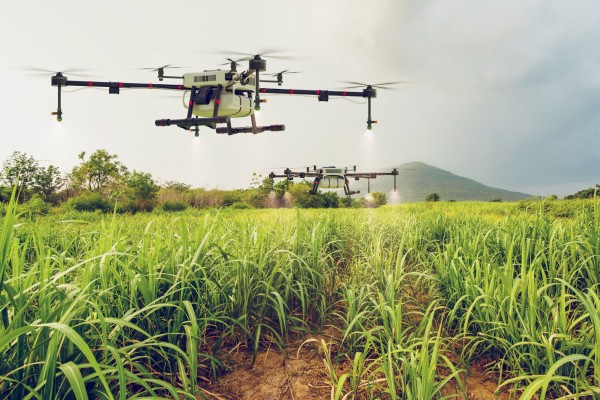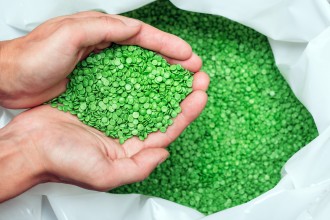What drives us to talk about Agtech? ensun aims to speed up global business progress. Our web crawlers gather data, and our text-based algorithms organize it systematically. By combining our internal data with external sources, we offer insights into the latest technologies and spotlight the top innovators behind them.
For this report, we've analyzed over 373+ relevant companies within the agricultural tech sector.
The encyclopedia Britannica describes agricultural technology as the “application of techniques to control the growth and harvesting of animal and vegetable products”, where techniques not only cover how growth and harvesting is done, but also with what tool.
Before we look at more specific tools, let’s dive into forecasted developments for Agtech.
Future Projections for Agricultural Technology
Agricultural technology is becoming increasingly requested. Data suggests the smart farming market alone is expected to triple in size. In 2021 its size was USD 12.75 billion, which will likely increase to USD 33 billion by 2027. This surge is driven by a multitude of factors that promise to impact not just farms, but our entire food system and way of life.
Deloitte points out, there are a few steps to be done, to adapt accordingly:
Empowering Farmers: Equipping farmers with the knowledge and skills to utilize these new technologies is crucial. This can involve educational programs on various solutions, from data analysis to sensor-based tools.
Building a Sustainable Future: AgTech presents a golden opportunity to promote eco-friendly practices. Developing technologies for water conservation, reduced emissions, and sustainable resource management will be key.
Fostering Collaboration: Effective communication and collaboration between farmers, tech companies, policymakers, and consumers will be essential to ensure the responsible and equitable implementation of solutions.
By fostering smarter farming practices, AgTech has the potential to bring us more affordable and abundant food on our plates. Additionally, the creation of new jobs in data analysis, engineering, and other tech-related fields within rural communities can stimulate the overall economy. In short, technologies in agriculture are poised to cultivate a more secure, sustainable, and prosperous future for all.
Latest Technologies in Agriculture and Their Top Innovators
Because the possible future of technologies in agriculture is now established, what exactly are the innovations? This section goes beyond typical buzzwords like Cloud Computing or AI. Instead, we will try to introduce you to other relevant industry-driven topics, that are gaining traffic, but are not too prevalent in the public eye. All while giving credit to the top innovators in their field.
So, let's take a closer look at very promising technological trends.
Soil Sensors
A soil sensor is a big part of precision farming. By being a specialized device utilized to gauge the moisture content within soil, they serve as a vital tool across multiple domains including agriculture, horticulture, climate research, and environmental studies. These sensors, available in various types such as capacitance-based or Time Domain Reflectometry (TDR) sensors, offer precise measurements of soil moisture levels. By accurately assessing soil moisture, they empower users to implement targeted irrigation strategies, thereby conserving water resources while promoting optimal plant health and growth.
Top Innovators
- EarthScout manufactures innovative Cellular Soil Moisture Sensors and Weather Stations, aiming to support sustainable agriculture through IoT technology.
- Stevens Water Monitoring Systems offers innovative solutions for water resource data acquisition, known for simplicity, efficiency, Bluetooth connectivity, and cloud-based data acquisition with M2M suite.
- UgMO develops soil monitoring tech for real-time insights, supports water conservation, and controls all aspects of its solutions.
Crop Yield Prediction
Crop yield prediction is a cornerstone of modern agricultural practices, offering farmers crucial insights into expected yields, optimal planting and harvesting times, and overall productivity enhancement. This predictive technique relies on diverse methods, ranging from environmental assessments to satellite monitoring and advanced AI/ML models.
To calculate expected crop yields, farmers typically select representative areas within their fields, conduct multiple samplings to determine an average crop size, and then count grains in a sample of heads or pods. Utilizing crop-specific grain weight data, they compute the yield per hectare.
Top Innovators
- Crop Systems utilizes precision agriculture (PA) to manage crop variability effectively. Biosprite, a natural solution provider, manages algae and reduces biofilm in irrigation systems, optimizing crop yield and quality.
- The Yield uses real-time data and AI to predict crop yields for commercial growers and large family-owned farms, enabling them to boost productivity, cut costs, and obtain better prices for their produce.
Aquaponic
Aquaponics combines aquaculture with hydroponics, utilizing nutrient-rich water from fish tanks to nourish hydroponically grown plants. This symbiotic relationship benefits both plants and fish, with plants purifying water for fish while utilizing fish waste as fertilizer. A Midwest study estimates annual energy costs for aquaponic systems at $5,991.06 out of a total operating cost of $29,321.16, highlighting its efficiency and sustainability in food production.
Top Innovators
- Aquaponics Garden specializes in global commercialization of aquaponic vertical farming. They prioritize sustainability by using innovative technology to reduce water usage and produce fresh food economically in challenging environments.
- Aquaponics Iberia combines fish farming with hydroponics to create sustainable ecosystems that produce high-quality fish and greens while saving water and reducing environmental impact.
Remote Sensing Technology
Remote sensing, a method of observing an area's physical characteristics from a distance by measuring its reflected and emitted radiation, finds applications across diverse sectors like agriculture, disaster management, and urban planning. Technologies include ground-based, airborne, and satellite systems, utilizing lasers, radar, LiDAR, and photogrammetry.
These technologies are a big part of automated farming and enable efficient monitoring of large areas and provide valuable data for analyzing environmental changes and managing resources effectively. Remote sensing aids in understanding Earth's dynamics and ecosystem health, contributing to informed decision-making processes in various fields.
Top Innovators
- Adatos.AI pioneers digital solutions for agriculture and Nature-Based Solutions worldwide. With AI and remote sensing technology, we empower real-time decision-making for productivity and sustainability, prioritizing collaboration, and powerful analytics.
- Intelfuse utilizes datafuse3D to optimize asset and vegetation programs, reducing System Average Interruption Duration Index (SAIDI) and System Average Interruption Frequency Index (SAIFI) while driving growth.
- Agriverts advances urban farming with AI-driven systems, making it accessible and efficient for sustainable food production. They merge traditional wisdom with technology for greener, resilient communities.
Artificial Seed
Artificial seeds use synthetic biology and are engineered to sprout and mature into plants under controlled environments, either in vitro or in vivo. They offer a precise method of plant propagation, distinct from both synthetic and natural seeds.
Synthetic seeds, in contrast, are plant propagation materials that have undergone artificial encapsulation, while natural seeds are unprocessed seeds from non-monogerm varieties. Within artificial seeds lies the embryoid, possessing the remarkable ability of cell totipotency, enabling plant growth through embryonic development under optimal conditions. This unique structure allows artificial seeds to mimic the germination and growth processes of natural seeds, presenting opportunities for enhanced agricultural practices and crop production.
Top Innovators
- Southern Hydroseeding offers hydroseeding and landscaping services across Victoria, South Australia, and southern New South Wales, with expertise in instant turfs, synthetic grass, lawn seed, fertilizers, and artificial hedging. They also provide professional landscaping services like sprinkler systems and irrigation, serving clients across multiple states.
- KWS Group is a top global seed producer, renowned for research and breeding programs that enhance genetic potential. They provide high-yield seeds and agricultural expertise, serving farmers as trusted partners. KWS prioritizes sustainability and anticipates certification for their innovative feeding concept.
Smart Fertilizers
Smart fertilizers release nutrients in sync with plant demand, maximizing efficiency and minimizing nitrogen pollution. This proactive approach reduces environmental damage and social costs associated with nitrogen runoff, making them a sustainable and efficient solution for agriculture. By optimizing nutrient release, smart fertilizers contribute to a more environmentally friendly and economically viable approach to agricultural nutrient management.
Top Innovators
- Nitricity is electrifying nitrogen fertilizer production to reduce global greenhouse gas emissions. Their mission is to provide sustainable fertilizer solutions for fields, farmers, and the environment.
- Earth Smart Solutions provides environmentally safe products for personal, commercial, and industrial use, formulated with naturally occurring ingredients. Their bio-based products are tough on industrial applications but safe for household and environmental use.
- Antonio Tarzana provides agricultural products for plant nutrition and crop protection, including fertilizers, biostimulants, and phytosanitary products.
In conclusion, the agricultural sector is undergoing massive changes driven by technological advancements. These innovations promise to revolutionize farming practices, enhance sustainability, and foster economic prosperity within the industry. Embracing these trends will lead to more efficient food production and environmental stewardship, shaping a promising future for agriculture. But agricultural technology is not the only field evolving. Our B2B search engine unveils you suppliers for the exact technology you are looking for – globally and inter-industrial.
Start searching here now.
FAQ about Agtech
Agricultural technology, often referred to as "agritech," encompasses a wide array of disciplines and tools aimed at enhancing agricultural productivity. This includes a diverse range of innovations such as vehicles, robotics, computers, satellites, drones, mobile devices, and software solutions.
Various sustainable agricultural methods prioritize environmental conservation, social equity, and economic viability. Examples include organic farming, regenerative agriculture, permaculture, agroecology, and precision agriculture.
Renewable energy technologies, like solar, wind, and hydropower, are at the forefront of the green technology revolution. Harnessing the power of nature's resources—sunlight, wind, and water—they provide clean and sustainable energy solutions. Solar panels, in particular, have emerged as an iconic representation of green technology.
The transformative influence of technology on agriculture is exemplified by the automation of irrigation systems. These innovations have fundamentally changed the way water is delivered to crops, enhancing the effectiveness of water distribution and ultimately improving the quality and quantity of agricultural yields.
In agriculture, technological advancements have greatly boosted farmer productivity by enabling increased food production with reduced labor, lowering input expenses, enhancing data management capabilities, and fostering adaptation to climate change.
Quickscout
Looking for suitable
technology providers?
Start scouting!





